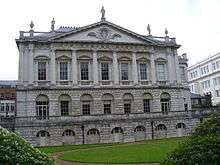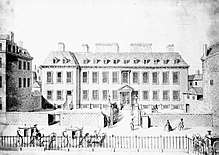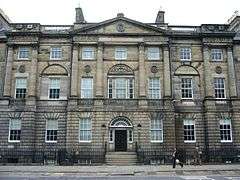Townhouse (Great Britain)
In British usage, the term townhouse originally refers to the town or city residence, in practice normally in London, of a member of the nobility or gentry, as opposed to their country seat, generally known as a country house or, colloquially, for the larger ones, stately home. The grandest of the London townhouses were stand-alone buildings, but many were terraced buildings.

British property developers and estate agents often market new buildings as townhouses, following the North American usage of the term, to aggrandise modest dwellings and to avoid the negative connotation of cheap terraced housing built in the Victorian era to accommodate workers. The aristocratic pedigree of terraced housing, for example as survives in St James's Square in Westminster, is widely forgotten. The term is comparable to the hôtel particulier, which housed the French nobleman in Paris, and to the urban domus of the nobiles of Ancient Rome.
Background
Historically, a town house was the city residence of a noble or wealthy family, who would own one or more country houses, generally manor houses, in which they lived for much of the year and from the estates surrounding which they derived much of their wealth and political power. Many of the Inns of Court in London served this function; for example, Gray's Inn was the London townhouse of Reginald de Grey, 1st Baron Grey de Wilton (d. 1308). From the 18th century, landowners and their servants would move to a townhouse during the social season (when balls and other society gatherings took place).[1]
From the 18th century, most townhouses were terraced; it was one of the successes of Georgian architecture to persuade the rich to buy terraced houses, especially if they were in a garden square. Only a small minority of them, generally the largest, were detached; even aristocrats whose country houses had grounds of hundreds or thousands of acres often lived in terraced houses in town. For example, the Duke of Norfolk owned Arundel Castle in the country, while from 1722 his London house, Norfolk House, was a terraced house in St James's Square, albeit one over 100 feet (30 metres) wide.
England
London
.jpg)
In the Middle Ages, the London residences of the nobility were generally situated within the walls or boundary of the City of London, often known as "Inns". For example, Lincoln's Inn was the town house of the Earl of Lincoln, and Gray's Inn of the Baron Grey de Wilton. They gradually spread onto the Strand, the main ceremonial thoroughfare from the City to the Palace of Westminster, where parliamentary and court business were transacted. Areas such as Kensington and Hampstead were countryside hamlets outside London until the 19th century, so mansions in these areas, such as Holland House, cannot be considered as true historical townhouses. Bishops also had London residences, generally termed palaces, listed below. Many aristocratic townhouses were demolished or ceased to be used for residential purposes after the First World War.
The greatest residence on the Strand was the Savoy Palace, residence of John of Gaunt, Duke of Lancaster, the richest man in the kingdom in his age. The Strand had the advantage of river frontage to the Thames, which gave the nobles their own private landing places. The next fashion was to move still further westwards to St James's, to be near the Tudor royal court. In the 18th century, Covent Garden was developed by the Duke of Bedford on his Bedford Estate, and Mayfair by the Grosvenor family on their Grosvenor Estate. The final fashion before the modern era was for a residence on the former marsh-land of Belgravia, developed after the establishment of Mayfair by the Duke of Westminster. The following examples, most of which are now demolished, are comparable to the Parisian hôtel particulier:
Secular houses

on Leicester Fields, 1748]]
- The Albany
- Apsley House, Duke of Wellington;
- Baynard's Castle, City of London, Earls of Pembroke 1551-1666;[2]
- Berkeley House, residence of Baron Berkeley of Stratton (a junior branch of Baron Berkeley of Berkeley Castle in Gloucestershire), seated at Bruton Abbey in Somerset, was on the site of Bruton Street, Stratton Street and Berkeley Square in Mayfair, and later became Devonshire House.
- Berkeley's Inn, Baynard's Castle, City of London, town house of Thomas de Berkeley, 5th Baron Berkeley (1353-1417), which he gave in his will to Robert Knollis, a Citizen of London.[3]
- Bedford House
- Bridgewater House, Westminster
- Buckingham House (now Buckingham Palace)
- Burlington House (now home of the Royal Academy)
- Cambridge House
- Chandos House, 2 Queen Anne Street, Marylebone; 3rd Duke of Chandos
- Chesterfield House (demolished 1937, now eponymous Mayfair block of flats)
- Chudleigh House, Knightsbridge, Westminster, later called Kingston House
- Clarence House, the residence of the late Queen Elizabeth the Queen Mother and now the residence of Charles, Prince of Wales
- Clarendon House
- Crewe House, Curzon Street, Mayfair, currently the Saudi Arabian embassy
- Devonshire House (formerly on Piccadilly, opposite present Ritz Hotel. Formerly Berkeley House)
- Dorchester House
- Dudley House, London
- Essex House
- Grosvenor House (replaced by eponymous hotel); see also Peterborough House
- Harrington House formerly the London residence of the Earl of Harrington
- Hertford House, Cannon Row, home of Edward Seymour, 1st Earl of Hertford (1539-1621), son of the first builder of Somerset House. The present Hertford House in Manchester Square, home of the Wallace Collection, was built by one of his very distant cousins.
- Hungerford House, residence of Baron Hungerford until 1669. It later became the site of Hungerford Market and then Charing Cross railway station
- Kingston House, Knightsbridge, Westminster, formerly called Chudleigh House
- Knyvet House, residence of Thomas Knyvet, 1st Baron Knyvet (d.1622), now 10 Downing Street
- Lancaster House
- Lansdowne House
- Leicester House, Westminster
- Londonderry House (formerly on Piccadilly)
- Marlborough House, once a royal residence, now the Commonwealth Secretariat
- Montagu House
- Norfolk House
- Northumberland House (demolished)
- Pembroke House, Whitehall
- Peterborough House, Millbank, Westminster.
- Richmond House, built c.1660 by Charles Stewart, 3rd Duke of Richmond (of Cobham Hall in Kent) on the site of the bowling green of the Palace of Whitehall.[4]
- Somerset House, Strand
- Somerset House, Park Lane (built 1769–70; demolished 1915)
- Spencer House, formerly the London residence of the Earls Spencer
- Stratford House, built 1770-66 by Edward Stratford, 2nd Earl of Aldborough.
- Suffolk Place, Southwark (Duke of Suffolk)
- Wentworth House, 5, St James's Square, built in 1748-51 by William Wentworth, 2nd Earl of Strafford, to the design of Matthew Brettingham The Elder.[5] in 1984 it was the Libyan "People's Bureau", gunshots from which caused the Murder of Yvonne Fletcher.
Episcopal palaces
- Ely Palace (Bishop of Ely)
- Arundel House (Bishop of Bath and Wells)
- Bromley Palace (Bishop of Rochester)
- Durham House (Bishop of Durham)
- Fulham Palace (Bishop of London)
- Lambeth Palace (Archbishop of Canterbury)
- Winchester Palace (Bishop of Winchester), Southwark;
- Rochester House (Bishop of Rochester), Southwark;[6]
- Waverley House (Abbot of Waverley), Southwark;[7]
- York House (Archbishop of York)
English provinces
Whilst most English examples of the townhouse occur in the capital, the provincial cities also contain some historical examples, for example Bampfylde House (destroyed in WW II) in Exeter, the county capital of Devon, the town house of Baron Poltimore of the Bampfylde family, whose main country seat was Poltimore House in Devon. Also in Exeter was Bedford House, also demolished, the town residence of the Duke of Bedford who resided principally at Woburn Abbey in Bedfordshire but required a base in the West Country from which to administer his vast estates there.
Scotland
Edinburgh

- Bute House - former residence of the Marquis of Bute in Edinburgh's Charlotte Square, now the official residence of the First Minister of Scotland[8]
- Dundas House - former Edinburgh home of Sir Lawrence Dundas, now the principal branch of the Royal Bank of Scotland
- John Knox House - 15th-century townhouse on the Royal Mile
- Old Moray House - 17th-century dwelling of the Earls of Moray in the Canongate
- Queensberry House - bought in 1689 by William Douglas, 1st Duke of Queensberry, now incorporated into the new Scottish Parliament Building and housing the office of the Presiding Officer
- The Georgian House, Edinburgh - restored 18th-century townhouse which is open to the public
Ireland
Dublin

- Leinster House in Dublin - residence of the Duke of Leinster (Ireland's premier duke) and now the seat of Oireachtas Éireann, the Irish parliament.
- Powerscourt House - Dublin residence of Viscount Powerscourt, a prominent Irish peer. It was sensitively converted into an award-winning shopping centre in the 1980s. (See an image of one of its decorated ceilings here.)
Georgian Dublin consisted of five Georgian squares, which contained the townhouses of prominent peers. The squares were Merrion Square, St Stephen's Green, Fitzwilliam Square, Ruthland Square (now called Parnell Square) and Mountjoy Square. Many of the townhouses in these squares are now offices while some have been demolished.[9]
See also
- English country house
- Great house
- Manor house
- Stately home
- List of house types
Notes
- For a description of an 18th-century town house in England, for example, see Olsen, Kirsten. Daily Life in 18th-Century England. Greenwood Publishing Group, 1999, pp. 84–85.
- Also see Stewart, Rachel. The Town House in Georgian London. Yale University Press for the Paul Mellon Centre for Studies in British Art, 2009.
- [[GEC Complete Peerage, Vol.10, p.406, note f
- Smith, Lives of the Berkeleys, Vol.II, pp.447 et seq
- "Richmond Terrace and House". UK Parliament. Retrieved 20 February 2020.
- http://www.5stjamesssquare.com/the-building/
- MacNamara, Memorials of the Danvers Family, p.120
- MacNamara, Memorials of the Danvers Family, p.120
- For a general discussion of town houses in Edinburgh, see Brown, Keith M. Noble Society in Scotland: Wealth, Family and Culture from the Reformation to the Revolutions. Edinburgh University Press, 2004, p. 203ff.
- For background, see Casey, Christine. The Eighteenth-Century Dublin Town House: Form, Function and Finance. Four Courts, 2010.
Further reading
- Cunningham, Peter. Handbook of London Past and Present, London, 1850 (see section 20: "Palaces & Chief Houses of the Nobility & Gentry in the Present Day).
- London's Mansions by David Pearce, (1986) ISBN 0-7134-8702-X
- The London Rich by Peter Thorold (1999) ISBN 0-670-87480-9
- Daisy, Countess of Fingall. Seventy Years Young. First published 1937 (autobiography of an Irish peer's wife, covering the late nineteenth and early twentieth century).
- Ros, Maggi, Life in Elizabethan England: A London and Westminster Directory, 2008